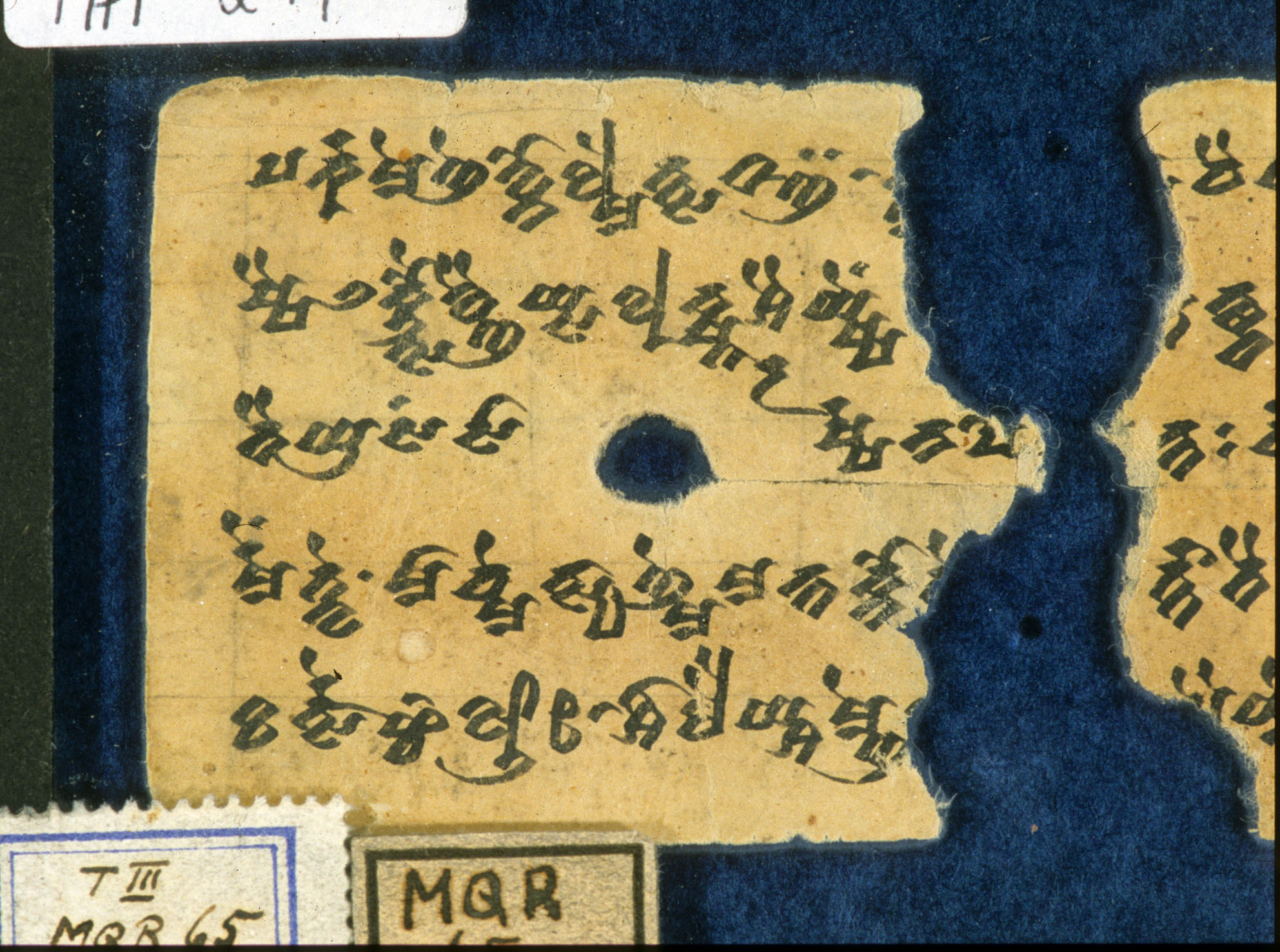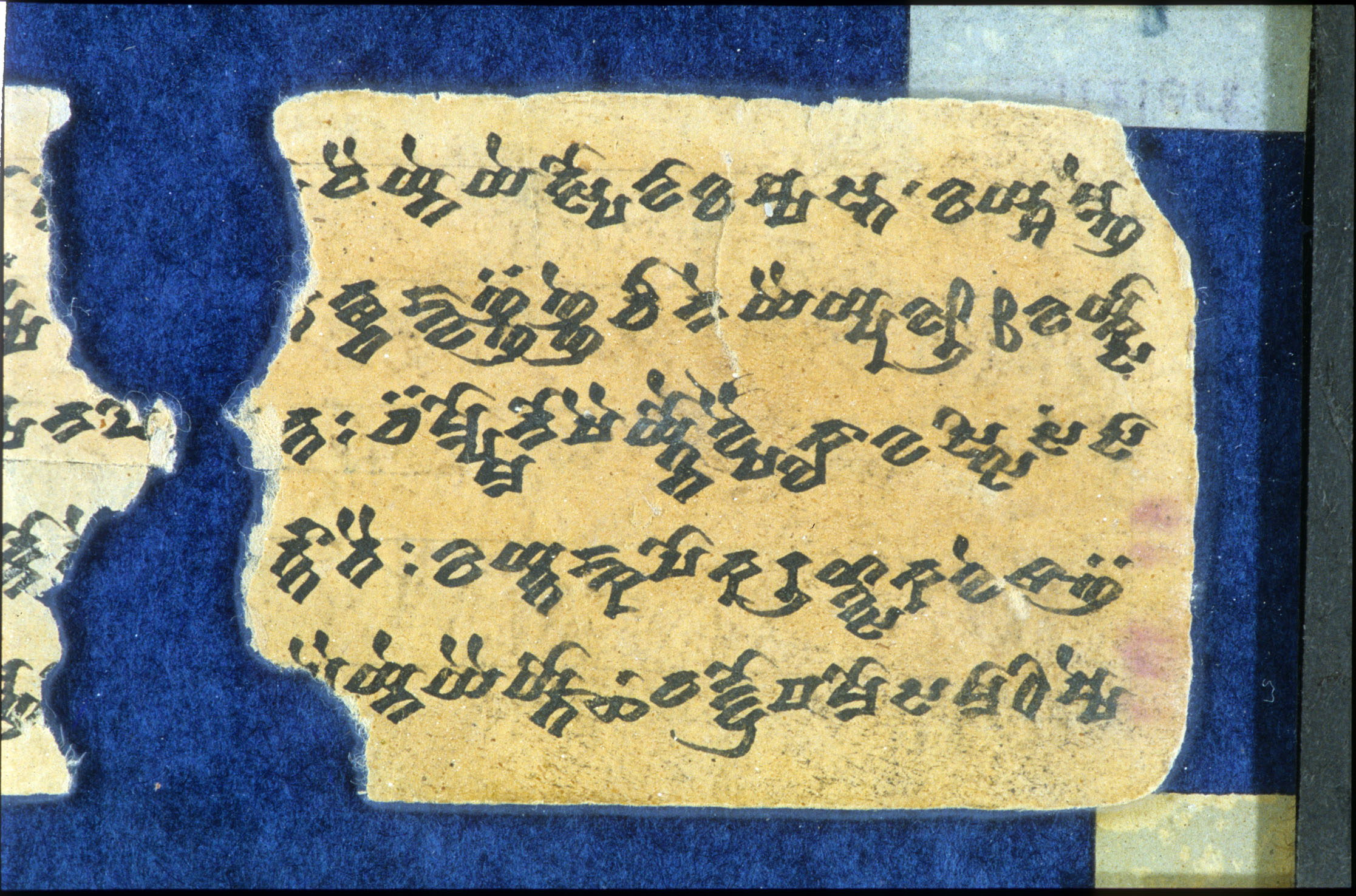THT 214
| Known as: | THT 214; B 214; Bleistiftnummer 2651 |
|---|---|
| Cite this page as: | Adrian Musitz (translation). "THT 214". In A Comprehensive Edition of Tocharian Manuscripts (CEToM). Created and maintained by Melanie Malzahn, Martin Braun, Hannes A. Fellner, and Bernhard Koller. https://cetom.univie.ac.at/?m-tht214 (accessed 05 Jul. 2025). |
Edition | |
| Editor: | Adrian Musitz (translation) |
Provenience | |
| Main find spot: | Kizil Ming-öy |
| Specific find spot: | Rothkuppelraum |
| Expedition code: | T III MQR 65 (on the frame), T III MQ 49 (on the fragment) |
| Collection: | Berlin Turfan Collection |
Language and Script | |
| Language: | TB |
| Linguistic stage: | classical |
| Add. linguistic characteristics: | archaic |
| Script: | classical |
Text contents | |
| Text genre: | Literary |
| Text subgenre: | Buddhastotra |
| Verse/Prose: | verse |
| Meter: | 444 (4x) |
Object | |
| Manuscript: | THT 210-214 |
| Material: | ink on paper |
| Form: | Poṭhī |
| Number of lines: | 5 |
Images
Images from idp.bl.uk by courtesy of the International Dunhuang Project, the Berlin-Brandenburgische Akademie der Wissenschaften, and the Staatsbibliothek zu Berlin – Orientabteilung.
Transliteration
| a1 | pa rka me ñe wno lme ntsa ta¯ ¯ñä • ·[m]· /// /// vai yne ye tspo wā ka ṣṣa sta • ai yśa mñe |
|---|---|
| a2 | ṣṣai la kutsau wñai ysa lu kṣta¯ ¯r śai yṣṣeṃ /// /// tsta ṅwa ññä ññe cī ne yai ypu 100 50 ai yksā |
| a3 | tai yra saṃ sā rṣṣa na p[o] /// /// nta : cä mpmo no ṣai ytnau wṣai klā wa stsi saṃ sā |
| a4 | rmeṃ twe • mā cme tsyā ñme ma nta kno ·e /// /// rttā tai : ai ytta ṅka po ka ru ṇntsa ka we sa¯ ¯ñä |
| a5 | ka rtse¯ ¯śc 100 50-1 śī lai yśa mñe /// /// [p]ai yne yai yto¯ ¯s̝ • va jjro pa mo sa mā dhi ṣṣe |
| lf | 80 7 |
| b1 | cä ṅke nau ttse • snai yko rñe ṣṣe ·[au] /// /// [¯]ñ[ä] ā śce i me ṣṣa • ñe mka lywe ṣṣe ma hu |
| b2 | rsa s̝a ñta rne yai ytu 100 50 2 [kt]· /// /// ma lkau kre ñcä sa mā ka ne • e mpreṃ pi lko wa |
| b3 | rñai kre nta o ktpo kai yñ· • [ai] /// /// ·[ś]· mñe ṣṣeṃ ye peṃ e ṅku wai yptā rma śne : wi kṣṇu ne |
| b4 | stwe po yśi ññe ṣṣe po yu kṣe ñcai /// /// ntai ytsñe ṣṣai wrā kai pā yā sta kle nau ntsai : |
| b5 | po yśi ññe ṣṣa la cwe śe ñña po [ś]ai /// /// hmñä kte sa wa rñai lā¯ ¯ñcä kuse ṣpke na ṣṣi • ke |
Transcription
| lf | 80-7 |
Translation
| a1 | ... your moon arose to the beings. ... you separated... of all vaiyneyets... |
|---|---|
| a1+ | thou dost illuminate worlds by the light of [thy] knowledge |
| a2 | ... having entered dearness towards you... |
| a2+ | as you had come to know all the pains of the saṃsāra, |
| a3+ | you were able to report previous (events) from the saṃsāran1 |
| a4 | It is not (your) wish to be born. You have never praised life, for the good of us, with total compassion. |
| a5 | (Your) feet are adorned with the wheels moral behavior and knowledge; |
| a5+ | (Your) chest of thunderbolt-like-meditation is brillant (?). |
| b1 | Your head that is your thought (is adorned) with the jewel of diligence. |
| b1+ | The crown of your own head is adorned with the diadem of good fame. |
| b2 | ... having put on the two good samāka... (?)n2 |
| b2+ | True insight, etc. are the eight good arms. |
| b3 | Having seized the weapons of knowledge in each hand, you are Viṣṇu, all knowing, all conquering. |
| b4 | You blew the resounding shell of faith. |
| b5 | The Buddha-voice emerged in all worlds. Starting with Brahma, the kings and those who... of the land... |
Other
| a1+ | Mit der Leuchte der Erkenntnis erleuchtest du die Welten. (Schmidt 1974: 468) |
|---|---|
| a2+ | Du hast auch wissen lassen alle Saṃsāra(leidenden), denn du warst fähig, das Frühere zu erzählen aus dem Saṃsāra. (Schmidt 1974: 457) |
| a4 | Nicht [ist dir] der Wunsch geboren zu werden [gewesen]. Niemals fürwahr hast du (das Leben) gepriesen. (Schmidt 1974: 170) |
Commentary
Philological commentary
| n1 | Translation adapted from Winter apud Malzahn 2010: 544. It is not clear what nauwṣaimeans. |
|---|---|
| n2 | Interpreting kreñcä samākane as a dual. |
Alternative linguistic/paleographic classifications
| Peyrot 2008 | A3 |
| Tamai 2011 | C3 |
| Tamai 2011 | C14 |
References
Online access
Edition
Sieg and Siegling 1953: 127-128
Translations
Adams 2012a: a1 a2 (26); Hackstein 1995: a1 (128), a1 a2 (124), b4 (98); Krause 1952: a2 a3 a4 (187); Peyrot 2013b: b4 (772); Schmidt 1974: a1 a2 (468), a2 a3 a4 (457), a4 (170); Thomas 1954: a2 a3 a4 (739); Thomas 1957: a1 (214), a2 (261), a2 a3 (174), a4 (175), a5 (264), b1 (264), b3 (175); Thomas 1969: a1 (253), b5 (238); Thomas 1993: a1 a2 (201); Thomas 1997: b3 b4 (85)
Bibliography
Adams, Douglas Q. 2012a. “Shedding light on *leuk- in Tocharian and Hittite and the wider implications of reconstructing its Indo-European morphology.” Tocharian and Indo-European Studies 13: 21–55.
Hackstein, Olav. 1995. Untersuchungen zu den sigmatischen Präsensstammbildungen des Tocharischen. HS Erg.-Heft 38. Göttingen: Vandenhoeck & Ruprecht.
“The International Dunhuang Project: The Silk Road Online.” n.d. http://idp.bl.uk.
Krause, Wolfgang. 1952. Westtocharische Grammatik, Band I. Das Verbum. Heidelberg: Winter.
Malzahn, Melanie. 2010. The Tocharian verbal system. Leiden/Boston: Brill.
Peyrot, Michaël. 2008. Variation and change in Tocharian B. Vol. 15. Leiden Studies in Indo-European. Amsterdam/New York: Rodopi.
Peyrot, Michaël. 2013b. The Tocharian subjunctive. A study in syntax and verbal stem formation. Vol. 8. Brill’s Studies in Indo-European Languages & Linguistics. Leiden/Boston: Brill.
Schmidt, Klaus T. 1974. “Die Gebrauchsweisen des Mediums im Tocharischen.” PhD, Universität Göttingen.
Sieg, Emil, and Wilhelm Siegling. 1953. Tocharische Sprachreste. Sprache B, Heft 2. Fragmente Nr. 71-633. Edited by Werner Thomas. Göttingen: Vandenhoeck & Ruprecht.
Tamai, Tatsushi. 2011. Paläographische Untersuchungen zum B-Tocharischen. Innsbrucker Beiträge zur Sprachwissenschaft 138. Innsbruck: Institut für Sprachen und Literaturen.
Thomas, Werner. 1954. “Die Infinitive im Tocharischen.” In Asiatica. Festschrift Friedrich Weller. Zum 65. Geburtstag, gewidmet von seinen Freunden, Kollegen und Schülern, edited by Johannes Schubert and Ulrich Schneider, 701–64. Leipzig: Harrassowitz.
Thomas, Werner. 1957. Der Gebrauch der Vergangenheitstempora im Tocharischen. Wiesbaden: Harrassowitz.
Thomas, Werner. 1969. “Bemerkungen zum Gebrauch von toch. A ptāñkät [B pañäkte, pudñäkte], A koṃ [B kauṃ]: A koṃñkät [B kauṃñäkte] usw.” Orbis 18: 235–68.
Thomas, Werner. 1993. Parallele Texte im Tocharischen und ihre Bewertung. Vol. 5. SbWGF, XXX. Stuttgart: Steiner.
Thomas, Werner. 1997. Interpretationsprobleme im Tocharischen. Unflektiertes A puk, B po “ganz, all, jeder”. Vol. 3. SbWGF, XXXV. Stuttgart: Steiner.
Gippert, Jost, Katharina Kupfer, Christiane Schaefer, and Tatsushi Tamai. n.d. “Thesaurus Indogermanischer Text- und Sprachmaterialien (TITUS): Tocharian Manuscripts from the Berlin Turfan Collection.” http://titus.fkidg1.uni-frankfurt.de/texte/tocharic/thtframe.htm.








